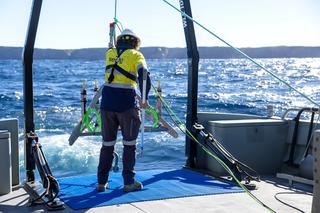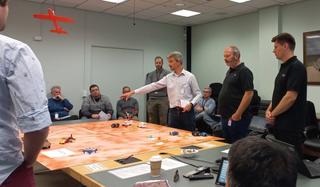Executive summary
The United Kingdom possesses an established civilian research and development (R&D) ecosystem, comprised of its world-class universities, long-term government research funding programs and an extensive private innovation sector, combined with a dynamic defence innovation infrastructure. The United Kingdom’s economic structure is also increasingly oriented towards a ‘knowledge economy’, which emphasises intellectual and creative outputs over natural resources and heavy industrial might. This combination of attributes renders the United Kingdom an extremely high-value science and technology marketplace and a crucial partner in the AUKUS Pillar II endeavour.
The United Kingdom’s technological strengths are concentrated in several of the most high-value advanced capabilities for both defence and civilian uses, including undersea autonomy, sensors, Artificial Intelligence (AI) and quantum computing. While the United Kingdom’s higher education system has been a crucial instrument in the development of these capabilities, there has been an increasing trend in which cutting-edge innovation is taking place within the private sector,1 meaning that sovereign access to technology becomes a negotiation between industry and the state. Many factors have underpinned this shift, but the inability to secure labs with sufficient British native students and the absence of sufficient long-term funding streams have been instrumental. Other areas of inefficiency and fragmentation also impede the effectiveness and growth of the United Kingdom’s innovation capacity.2
This paper provides an overview of the United Kingdom’s university and wider R&D ecosystem, assesses its capacity to meaningfully contribute to the AUKUS trilateral endeavour and makes recommendations towards enhancing the United Kingdom’s instruments of innovation. It has been informed by interviews with senior stakeholders from across the sector. The paper argues that the United Kingdom has one of the most significant innovation foundations in the world, and that many of the levers to unleash its potential and foster a more productive enabling environment lie within the purview of the state. To build a viable, sovereign innovation ecosystem that supports the AUKUS Pillar II priority capabilities, the UK Government should pursue the following actions:
Funding
- Earmark specific UKRI and ARIA funds as dedicated AUKUS research funding streams, providing multi-year, mission-oriented grants aligned with technology priorities and emphasising established areas of UK strength.
- Extend multi-year funding guarantees for catapults, which commit them to long-term investments in AUKUS technology lines.
- Create an extraordinary procurement mechanism in the Ministry of Defence (MoD) similar to that which supports Ukraine, to enable the streamlining of AUKUS capability development procurement processes with a greater acceptance of risk.
- Tie major MoD contracts for primes to supporting the scaling and due diligence of viable sovereign SMEs and/or investments in the wider innovation ecosystem.
Foundational research and research commercialisation
- Build new ‘Centres of Excellence’ aligned with AUKUS capabilities, with accredited, high-security labs with dedicated research staff operating classified environments linked to innovation hubs at catapults and clusters.
- Enable the creation of bridging research units within select universities, allowing the dividends of the defence research environment to be brought into the public domain for wider research and commercial applications.
- Streamline security clearance processes, introducing a fast-track vetting scheme for researchers in AUKUS priority areas.
- Establish AUKUS PhD pipelines as industry partnerships, offering part-research, part-placement structures which guarantee jobs, and offer early career research exchanges with US and Australian counterparts.
- Strengthen and upskill the Research Collaboration Advice Team (RCAT) to act as a ‘trusted research gateway’ and develop an aligned SME compliance support unit.
- Seek to negotiate trilateral AUKUS agreements on fair Intellectual Property use, allowing universities to publish non-sensitive elements of research.
Political resilience
- Undertake a focused study on how defence research and innovation can drive tangible Return on Investment (ROI) for the United Kingdom’s global competitiveness, strategic capability and economic growth.
- Conduct a trilateral AUKUS audit of supply chain resilience, so that vulnerabilities and individual national dependencies affecting the research commercialisation pathway can be mapped, anticipated and mitigated.
- The UK Prime Minister and Defence Secretary should make clear public statements directed to the financial investment community, universities and the civilian innovation sector, which frame defence capabilities as vital and noble sovereign missions.
Introduction
While the nuclear submarine capability development and capacity uplift project of AUKUS Pillar I has dominated four years of public debate surrounding the pact, its second workstream remains a more elusive and poorly defined endeavour. Pillar II of AUKUS focuses on the trilateral development of advanced capabilities and the process of driving alignment in science and technology, and industrial bases and supply chains between the three partners — Australia, the United States and the United Kingdom.
The United Kingdom brings some core strengths to this endeavour, and it is reasonable to argue that of the three partners, the United Kingdom could benefit most directly in the short term from AUKUS Pillar II, due to the overt prominence of technological development in the nation’s prosperity agenda. The United Kingdom’s R&D ecosystem is substantial, contributing a significant proportion of economic output, for which the private sector is the largest driver of activity; however, the state remains a crucial enabling force.3
The key state actors in driving R&D activity are the UK Research and Innovation (UKRI) agency, which steers major elements of civilian science and technology funding and missions; the Defence Science Technology Laboratory (Dstl), which coordinates defence-oriented research; and the Defence and Security Accelerator (DASA), which funds early-stage defence innovation and scaling efforts. The Advanced Research and Invention Agency (ARIA) was also founded in 2022 to support higher-risk research endeavours, mainly focusing on the emerging civilian technology, computational and bioscience sectors.4
The United Kingdom’s world-leading university sector delivers foundational research, with capabilities spread across regional specialisms, often connected to, or embedded in, catapults (place-based research commercialisation ventures run by Innovate UK), and research clusters.5 In the private sector, large defence primes such as BAE Systems, Rolls-Royce and Babcock anchor industrial capability, and a growing start-up ecosystem drives early-stage research commercialisation.6
The United Kingdom holds technical depth in key Pillar II technologies,7 as well as productive research and development (R&D) transition and translation mechanisms, which create pathways to move research innovation into prototypes, defence programs and technology spin-outs.8 Its defence primes, themselves formidable defence innovators, have systems-integration capabilities to support the joint development and testing of platforms, unmanned systems and sustainment approaches.
It is reasonable to argue that of the three partners, the United Kingdom could benefit most directly in the short term from AUKUS Pillar II, due to the overt prominence of technological development in the nation’s prosperity agenda.
There are also some prominent constraints and limits to the UK contribution to AUKUS Pillar II, which will need to be addressed to support the project’s outcomes. Notably, the United Kingdom lacks the direct government funding scale and mass production capability of the world’s largest R&D nations, and continues to be plagued by workforce gaps in specialised engineering talent, as well as critical supply chain vulnerabilities.9 Success in AUKUS will require vast improvements to each nation’s existing sovereign capacities, but also their effective integration, to achieve the compound benefits of pooling US industrial scale, UK technical depth and Australian industrial investment.
It is self-evident that the political landscape surrounding AUKUS — a political project to address a geopolitical challenge — has evolved considerably in the four years since its announcement in September 2021, not least of all because the political project itself has become a geopolitical challenge. The future of AUKUS as a trilateral endeavour will lie in its successful alignment with the posture and priorities of the Trump administration. If it is able to achieve this, it can serve as a prototype of the benefits of allied scale and strategic congruence, which enhances US and Western competitiveness towards China. With a considerably stronger emphasis on delivery likely to underpin Pillar II activities moving forward, it is incumbent on all three partners to focus simultaneously on the enrichment of their national strengths as well as the construction of a trilateral enterprise. AUKUS, therefore, becomes a project that successfully straddles a greater emphasis on sovereign capability in the pursuit of the most impactful realisation of collective allied capability.
The UK system is most effective when an organising principle drives the implementation of a strategic concept. Its short-term capabilities are evidenced in the civil service’s successes in delivering major international summits and rapidly mobilising taskforces such as the Afghanistan evacuation scheme, and its medium-term achievements are visible in the implementation of the Indo-Pacific ‘tilt’ after Brexit. For this reason, the UK Government should harness AUKUS as a prism through which to pursue a renaissance of the role of the nation’s universities in its national security architecture, and to build on foundational R&D strengths to achieve a truly flourishing and well-financed innovation ecosystem.
This paper has been informed by interviews with senior representatives from leading UK universities, higher education groups, industry and research bodies, whose contributions are not attributed in order to protect their anonymity and allow for candid reflections. It was clear from these conversations that the United Kingdom’s R&D ecosystem responded enthusiastically to the announcement of AUKUS and that hopes for substantive, coordinated programs and funding streams are at risk of being extinguished. The Pentagon-led review of AUKUS, conducted by the Trump administration, due to deliver before the end of 2025, provides an opportunity and a responsibility to recalibrate the United Kingdom’s approach to Pillar II and to better harness the full suite of R&D enabling instruments available to the UK Government.
UK universities' capabilities and constraints in AUKUS Pillar II R&D
UK universities have defined strengths across several of the AUKUS Pillar II capabilities, with specialisms concentrated in certain geographical centres. In general, the United Kingdom punches considerably above its weight in science and applied defence R&D, while relying on alliance structures to achieve manufacturing at scale.10 Despite the progress being made by other nations, notably China and India, the United Kingdom has retained one of the most substantive research outputs in the world. The latest available UK Government data demonstrates that the United Kingdom produces 6% of the global share of publications, almost 9% of the global share of citations, and 12% of the most highly cited publications. The United Kingdom is also the first-ranked nation globally for field-weighted citation impact.11 These competitive contributions reflect the fact that UK universities have retained their strong international position, with three universities in the global top ten, and six in the top ten within Europe.12
Higher education institutions tend to have specialised and compounding areas of excellence, which evolve to meet contemporaneous defence innovation needs. For example, the University of Southampton has a Marine and Maritime Institute with specialisms in hydrodynamics, naval architecture and undersea robotics.13 The Universities of Bristol, Surrey and Lancaster are recognised for their skills in cybersecurity and resilient networks, and the University of Cranfield has specialisms in propulsion, materials science and high-speed systems.14 The University of Oxford, the University of Cambridge and Imperial College London have strengths in AI, reinforcement learning and decision-making systems. The University of Birmingham excels in quantum navigation and gravity sensors with maritime applications, while the University of Oxford and UCL Quantum Centres lead in quantum communications and sensors.15 Oxford’s commercial achievements are especially notable. In the space of two months in 2025, quantum computing start-up Oxford Ionics was acquired by the American IonQ in a deal valued at US$1.075 billion, and medical technology pioneer OrganOx is being bought by Terumo for a record US$1.5 billion.16

Universities’ strengths are deepened by having a holistic structure of cross-pollination across mutually reinforcing fields. Many of the universities with the greatest capabilities in AI, for example, are home to outstanding mathematics, physics and computer science courses and expertise. The sustainment of other universities with highly defined specialisms is also made possible by long-standing relationships with the UK Government and effective research commercialisation pathways with industry. For example, Cardiff University, which houses the Institute for Compound Semiconductors, benefits from the creation of the Compound Semiconductor Centre, a joint venture with semiconductor firm IQE.17 This research commercialisation enterprise has been further enriched by state investments in building a regional semiconductor cluster, which provides reinforcing infrastructure and workforce to the benefit of both the university and the private sector firms.18
UK universities have demonstrated enthusiasm for the AUKUS endeavour and have embraced opportunities for involvement in the pact. The University of Liverpool was one of the winners of the inaugural AUKUS Electronic Warfare Innovation Challenge, and universities remain eligible participants for other active challenges being led by DASA.19 Universities have also contributed to the public debate and scrutiny around AUKUS, including making submissions to the House of Commons Defence Committee’s AUKUS Inquiry, arguing that universities should be given greater direction within Pillar II delivery.20 UK universities have been involved in several trilateral higher education frameworks, most notably King’s College London’s role as the UK anchor of the Security & Defence PLuS initiative, a global partnership advancing security, defence innovation and policy across partner universities in the United Kingdom, the United States and Australia. While it predates AUKUS, it has been strengthened to focus more specifically on the pact and its opportunities.21 Overall, universities’ enthusiasm for AUKUS has not been met by significant engagement from the UK Government, and there are considerable barriers to the fulsome and effective participation of UK universities within AUKUS Pillar II, which will need to be overcome.
There are considerable barriers to the fulsome and effective participation of UK universities within AUKUS Pillar II, which will need to be overcome.
The first barrier to the participation of UK universities in AUKUS lies in security, classification and clearance constraints. Many AUKUS Pillar II projects involve classified information and export-controlled technologies, and most university researchers do not hold security clearances and struggle to secure them. The process of applying for and obtaining security clearances can be extremely protracted and inject inefficiencies into a sector seeking to persuade impatient industry and government of its capacity to emphasise pace.22 UK campuses are also highly internationalised, with around one-third of academic staff and over two-fifths of postgraduate research students non-UK nationals.23 Universities, therefore, can struggle to attract sufficient ‘home’ students (UK nationals) to be able to securely operate labs supporting the development of sovereign capabilities.
The second barrier relates to capacity and capability constraints. Navigating trilateral export control regimes remains a complex task, and many universities have limited in-house compliance capacity to undertake this work. Universities may lack secure labs, classified IT networks and controlled-access facilities to conduct sensitive AUKUS-related research. The uncertainty that surrounds constantly evolving government stances on research security can have a chilling effect on the institutional willingness to invest in the capability to prioritise complicated defence partnerships.24 There is also a scarcity of skilled researchers in priority fields, and poaching from universities into commercial and international institutions grows increasingly intense. Without investments from state bodies to level the playing field, it can be challenging for higher education institutions to compete.
The third barrier relates to cultural and normative tensions. Universities emphasise open science and publication, while AUKUS requires compartmentalisation. Universities often operate on open publication norms and knowledge dissemination models, which conflict with the need for secrecy in sensitive defence R&D or the demands of industry and government around sensitive intellectual property (IP).25 Some institutions and researchers are also hesitant to be associated with nuclear submarine or weapons-related programs, fearing backlash from staff, students or partners. Some universities are comfortable talking openly about their links to the United Kingdom’s defence innovation ecosystem, while others tend to downplay their relationships and even contain defence research to off-site locations. There is a view within the sector that some universities have been ‘captured’ by students who have engaged in persistent protest movements, which have coerced funding and collaboration choices.26
Furthermore, many UK academics have strong ties to non-AUKUS partners, including China. While the UK Government has sought to articulate a more clarified policy regarding research partnerships in sensitive areas, launching the Research Collaboration Advice Team (RCAT) service in 2021, universities are interpreting the guidance independently, and the ambiguities around dual-use functions can make it difficult to determine whether the potential application or the capability development itself should be considered high-risk.27 Recent research has found that a quarter of all AI research in UK universities is being conducted in partnership with Chinese universities,28 a staggering statistic given the significance of the capability to the United Kingdom’s sovereign economic and geopolitical interests. It could be anticipated that the United States may consider in the future that one of the requirements for AUKUS Pillar II cooperation is that the United Kingdom secures all AUKUS priority capabilities from Chinese research collaboration, which would precipitate a new cultural shift around institutional partnerships and have serious implications for universities’ existing financial models.
The fourth, and most important barrier to universities’ participation in AUKUS Pillar II, pertains to funding issues and a misalignment of incentives. The funding woes plaguing the university sector are well known; however, the challenges to higher education income streams are not uniform and remain nuanced for individual institutions. Government policy choices, namely on tuition fees, immigration and Brexit, have played a large role in the current predicament, and will continue to shape the optionality of universities to remedy them.29 For institutions facing challenging balance sheets, the prospect of defence research opportunities may not necessarily appear attractive, particularly given that their short-term contracts are not aligned with typical higher education funding structures nor university career pathways.
Even the United Kingdom’s most well-resourced universities are consistently required to make difficult decisions around viable research opportunities, and targeted state funding could unlock productive innovation and support the rapid commercialisation of world-leading capabilities.
The larger issue lies in funding scale. UKRI manages the lion’s share of the United Kingdom’s university funding streams, including the Higher Education Innovation Funding scheme, supporting vital research commercialisation functions such as proof-of-concept testing, which determines whether a discovery can achieve feasibility in real-world applications. UKRI was established to fund 80% of the full economic costs of research, with the intention of incentivising universities to source supplementary funding.30 In reality, a large proportion of this supplementary funding is being sourced from international students, including those from China.31 While the United Kingdom cannot compete with the level of direct fiscal transfers available to comparable US agencies, ensuring that a smaller number of priority areas are fully and independently funded would undoubtedly support the overall integrity of the sector.
Recent announcements regarding the UK Government’s Defence Industrial Strategy articulate an ambition to build new place-based defence innovation and manufacturing hubs, including drawing in universities as a crucial component of the research procurement process.32 This strategy appears to be motivated by the regional growth prospects of replicating industrial clusters like the Barrow enterprise for nuclear shipbuilding. While a worthy ambition with long-term growth prospects, it is important that the UK Government complements this endeavour by looking beyond a lens of regeneration and towards the universities with the capabilities that can drive short- and medium-term economic growth. Even the United Kingdom’s most well-resourced universities are consistently required to make difficult decisions around viable research opportunities, and targeted state funding could unlock productive innovation and support the rapid commercialisation of world-leading capabilities.
Strategic contributions of UK Government and industry to AUKUS Pillar II innovation
The United Kingdom’s R&D ecosystem outside of universities is critical for translating science into deployable capabilities. Much of its focus is already aligned with AUKUS Pillar II priorities; however, significant enabling functions are required to maximise its contributions.
The first group of actors are the UK Government research establishments, including the Defence Science and Technology Laboratory (Dstl), the Defence and Security Accelerator (DASA) and the National Nuclear Laboratory and Automatic Weapons Establishment (AWE). Dstl is the beating heart of the UK Ministry of Defence’s (MoD) science base, and leads classified research in areas such as undersea warfare, AI-enabled decision support, quantum sensing, cyber and weapons science. Dstl acts as a ‘problem owner’, bridging the MoD and industry to ensure that research is mission-driven. DASA provides rapid funding for defence innovation, especially supporting SMEs and dual-use technologies. It is a useful mechanism for accelerating prototypes in fields such as autonomy, cyber and undersea robotics. The National Nuclear Laboratory and AWE are key to nuclear propulsion research, materials resilience and secure handling. While they support functions relevant to Pillar I, their advanced materials expertise also supports Pillar II capabilities such as hypersonics and strike.
Several other institutions without a specific focus on defence also support the wider innovation ecosystem through research and capability development. For example, the Alan Turing Institute has excelled in AI ethics and safety research and is now being asked to focus more substantively on national security and geopolitical issues.33 The Engineering and Physical Sciences Research Council and Innovate UK have partnered to lead the UK National Quantum Technologies Programme, which supports national research hubs. The National Oceanography Centre contributes research towards the development of autonomous marine systems. The United Kingdom’s Government Communications Headquarters (GCHQ) and National Cyber Security Centre are leaders in both cyber defence and secure communications. And the National Protective Security Authority (NPSA) safeguards relevant sovereign IP and supports supply chain integrity.

One other state-supported body that deserves attention is the Advanced Research and Invention Agency (ARIA), a UK Government R&D funding agency established by statute in 2022. Its mandate is to fund high-risk, high-reward, speculative or underexplored areas of science and technology, which conventional funders — including the existing government bodies — often avoid because of risk, long timelines or interdisciplinarity. ARIA is sponsored by the Department for Science, Innovation and Technology, although it is independent in its decision-making, and has an initial funding scope of around £800 million for its first five years.34 ARIA’s mission is considerably broader than defence, and spans civil, environmental and health applications, amongst others. ARIA does not appear to have been involved in any official capacity in the AUKUS Pillar II endeavour thus far; however, its focus on general-purpose technologies such as quantum, AI and robotics means some of its outputs could indeed be applicable to AUKUS in the future. It is a youthful institution compared to many of the other government-led bodies, and ample opportunity remains to further define and advance its purview.
The United Kingdom’s defence ‘primes’ are also major drivers of UK R&D, as are the UK subsidiaries of major international primes. For example, BAE Systems leads in areas such as submarine and warship design, combat systems integration, and autonomous undersea vehicles and systems, and is also supporting AI integration for command and control.35 Rolls-Royce is recognised for its naval nuclear power and propulsion capabilities, and its role in hypersonic technology initiatives exploring enabling propulsion technologies.36 QinetiQ leads in electronic warfare research and integration, flight test and evaluation capabilities.37 The United Kingdom also has a thriving SME and start-up ecosystem, which is particularly skilled at rapid prototyping and dual-use innovation. For example, maritime robotics firm SeeByte, working on autonomy and sonar/navigation integration, has secured defence contracts via DASA and the US Navy,38 and quantum spinouts from UKRI hubs such as Aquark are transitioning into commercial start-ups with potential defence-grade applications.39
In addition to the government-directed bodies and industry, the United Kingdom’s R&D capability benefits from its catapult centres and applied research institutes. For example, the High Value Manufacturing Catapult, which has centres across the United Kingdom, specialises in areas such as composites, advanced manufacturing and additive manufacturing for aerospace and maritime components. The Compound Semiconductor Applications Catapult, based in Wales, leads on secure microelectronics, radar and communications hardware. The Digital Catapult, with centres in London, Bristol, Newcastle and Belfast, leads on AI, cyber-physical systems and 5G/6G communications relevant to Command, Control, Communications, Computers, Intelligence, Surveillance and Reconnaissance (C4ISR) and military operations support. These catapults and institutes provide translational infrastructure to scale up prototypes and strengthen supply chain resilience.
The final element of the United Kingdom’s R&D ecosystem is its defence innovation alliances. For example, the United Kingdom is a host nation for NATO’s Defence Innovation Accelerator for the North Atlantic (DIANA) framework, which offers direct linkage between UK innovation and allied capability development.40 Given the centrality of NATO to the United Kingdom’s strategic doctrine and its support for the integration of the ‘Indo-Pacific 4’ into NATO, it is highly plausible that the UK Government will seek to support the interoperability and future diffusion of some AUKUS capabilities within NATO. At the very least, the SSN-AUKUS submarines will be deployed in NATO waters, which creates a natural alignment. The United Kingdom is also developing closer defence ties with the European Union. In May 2025, the United Kingdom and European Union agreed on a Security and Defence Partnership, which includes enabling UK access to the European Union’s Security Action for Europe (SAFE) fund, a €150 billion instrument of loans for EU member states to finance joint procurement of defence equipment, to boost the European Union’s defence industry, and enhance interoperability and resilience.41
Universities are a central node in this system, as the primary producers of fundamental and early-stage research, and also major actors in commercialisation, skills and regional innovation projects through their rolein clusters and partnerships.
The United Kingdom’s innovation ecosystem operates broadly as a triple helix of universities and research institutes, government and public funding bodies, and industry and other applied innovation partners. Universities are a central node in this system, as the primary producers of fundamental and early-stage research, and also major actors in commercialisation, skills and regional innovation projects through their role in clusters and partnerships.
The key government structures that universities interact with include: the Department for Science, Innovation and Technology, which sets the national R&D strategy and oversees the £20 billion+ per annum public budget; UKRI, as the umbrella body for the research councils and funding bodies which provide competitive research funding; Innovate UK, which supports university-industry collaboration; Dstl and DASA, which universities bid towards in consortia for defence innovation challenges; and the national academies, such as the Royal Society and the British Academy, which provide fellowships and opportunities to input into government strategy. Universities and industry primarily connect through collaborative R&D grants, catapult centres, technology transfer offices and incubators, Knowledge Transfer Partnerships, which fund placements from universities in firms to deliver innovation projects, and regional innovation clusters, such as the Oxford-Cambridge Arc.
In summary, universities are the foundation of the United Kingdom’s R&D pipeline, providing basic research, vital expertise, and early-stage innovation. The UK Government is a crucial source of funding, regulation and convening, setting the overall strategy and funding priorities. Industry acts as a scaler and applier of research, commercialising knowledge and bringing it to market. The division of labour between these three nodes is both porous and dynamic, but generally follows a chain through which universities lead discovery, co-lead development and supply deployment.

There are many structural impediments to the United Kingdom’s R&D ecosystem outside of universities contributing meaningfully to the AUKUS Pillar II endeavour, some of which echo the challenges facing higher education institutions. The first of these pertains to information-sharing restrictions, as while defence primes can manage the handling of classified data, SMEs and catapult structures often lack the secure IT networks, cleared personnel and facilities to do so.42 Similarly, even after the opening up of the US International Traffic in Arms Regulations regime, the challenges of navigating complex export control frameworks can be simply too cumbersome for small compliance departments. Restrictions on sharing sensitive design data across borders also restrict joint prototyping opportunities and limit collaborative innovation.43
There are also constraints to be found in the United Kingdom’s industrial base, due to workforce shortages, a lack of manufacturing scale and persistent supply chain fragility. Defence primes and SMEs compete for limited home talent in AI, quantum, cyber and other priority areas such as undersea engineering, with the private technology sector often able to offer higher salaries. The United Kingdom’s industrial base also lacks redundancy in areas like semiconductors, advanced composites and propulsion systems, which limits the sovereign ability to manufacture at scale.44 The United Kingdom is also reliant on global supply chains subject to geopolitical disruption for crucial components such as rare earths, semiconductor chips and specialist components, heightening the risks inherent in its national capabilities.45
Governance and institutional challenges are also present. There are multiple overlapping bodies involved in the United Kingdom’s innovation ecosystem, which can fuel inefficiency and make it difficult to prosecute a cohesive national endeavour.46 The governance of IP is also a sticking point for collaboration at many decision milestones, with government-linked agencies and primes often seeking arrangements that cannot be supported by SMEs or other actors, and which act as an inhibitor to their participation in innovation pipelines.47 Other issues are more cultural in nature; for example, some dual-use or civil-leaning SMEs hesitate to engage in defence contracts due to reputational concerns, especially in sensitive areas like strike or nuclear-related systems.48
The final, and most important, major constraint on the UK R&D ecosystem is found in funding limitations. Industry partners rely on slow and fragmented MoD procurement cycles, which also disincentivise the risk-taking needed to support the growth of emerging technologies.49 For SMEs and start-ups, their early-stage innovation grants from bodies such as DASA may support sustainment, but are insufficient to achieve the scale needed for research commercialisation and deployment. Catapults are effective translational institutes, but face periodic funding reviews, which can undermine long-term planning and commercial certainty.50 Funding challenges across all three of these areas fundamentally impede progress on every other constraint, and it is therefore imperative for the UK Government to explore how to provide the necessary scale, certainty and consistency required for all components of the United Kingdom’s R&D ecosystem to fulfil their potential towards this AUKUS national mission.
Recommendations to overcome barriers and achieve success
To overcome the existing barriers in the United Kingdom’s R&D ecosystem and to support a robust UK contribution to AUKUS Pillar II success, the UK Government should:
Funding
Earmark specific funds as dedicated AUKUS research funding streams
A joint MoD-UKRI venture could provide UK universities with multi-year, mission-oriented grants aligned with AUKUS technology priorities, which are also major sovereign priorities. These should be designed in such a manner that, should there be any future risk to the sustainment of the AUKUS endeavour, these funding streams can continue without interruption as national or bilateral programs.
Harness ARIA’s unique culture for AUKUS
ARIA’s ability to fund speculative, long-term, boundary-spanning research is well-suited to the Pillar II technologies, particularly in areas such as quantum sensors, autonomy and advanced propulsion. Its organisational independence and flexibility could allow it to invest in foundational research that defence organisations or government defence procurement systems might not be willing to fund. There is an opportunity for ARIA to partner with defence labs, primes, or to support government initiatives to channel some of its programs to specifically align with Pillar II priority areas.
Pick winners to drive short-term global competitiveness
While university clusters can certainly support regional growth agendas, it is also crucial that funding initiatives support universities with established capabilities with the capacity to be truly globally competitive. The United Kingdom has some clearly defined strengths, and the pace of innovation requires urgent investments to drive scale and secure sovereign advantage.
Create an extraordinary procurement mechanism for AUKUS
Leveraging the Taskforce Kindred model that supports Ukraine,51 such a mechanism would enable the streamlining of AUKUS procurement processes with a greater acceptance of risk. Wholesale reform of the MoD procurement systems will take time and involve a fundamental shift in institutional culture, so the best short-term approach to seize the urgency of the AUKUS opportunity may well be to create something new.
Extend the multi-year funding guarantees for catapults, which commit them to long-term investments in AUKUS technology lines
Doing so will ensure these become more attractive mechanisms for both researchers and SMEs as agglomerating clusters of research commercialisation. Government agencies such as UKRI should also support universities’ participation in catapults.
Tie major MoD contracts for primes to supporting the scaling and due diligence of viable sovereign SMEs
While ensuring such requirements do not impede private sector innovation, primes could be required to demonstrate investments in the wider innovation ecosystem, such as the funding of advanced research programs, doctoral pipelines and training academies. Such initiatives could help to support a more balanced and growing innovation ecosystem, with benefits to both private and state-led innovation enterprises.
Foundational research and commercialisation
Build new ‘Centres of Excellence’ aligned with AUKUS capabilities
These should include accredited, high-security labs with dedicated research staff operating in classified environments. These Centres can link to innovation hubs at catapults and clusters, to support integrated commercialisation. Universities should be chosen based on their fundamental capabilities and willingness to forge vibrant defence research cultures. Support should also be given to these universities to establish secure IT networks, research and test facilities, so they can host defence and other sensitive projects.
Enable the creation of bridging research units within select universities
These units could allow the dividends of the defence research environment to be extrapolated from their secure functions and brought into the public domain for wider research and commercial applications. In the future, these units could also include the participation of accredited international researchers from a select group of allied nations identified as priority partners for AUKUS Pillar II.
Streamline security clearance processes
A fast-track vetting scheme should be established for researchers in priority areas such as AI, quantum computing, autonomy and cyber, to reduce delays. Expand security clearances for trusted researchers working on the geopolitical dimensions of AUKUS, so that the academic community can better support the public advancement and understanding of the pact and contextualise its significance across other disciplines and policy areas.
Establish AUKUS PhD pipelines as industry partnerships
Building off Cold War-era advanced engineering models, select universities could offer part-research, part-placement structures that guarantee jobs and offer opportunities for early career research exchanges with US and Australian counterparts.
Strengthen and upskill RCAT to act as a ‘trusted research gateway’
RCAT should provide a single point of contact to help universities navigate AUKUS compliance and funding opportunities, addressing export controls, IP protection and security clearances.
Develop an aligned AUKUS SME compliance support unit
Building on RCAT’s success, a unit jointly managed between DSIT and the MoD could provide legal, technical and administrative support for smaller firms pursuing AUKUS opportunities.
Seek to negotiate trilateral AUKUS agreements on fair IP use
These could allow universities to publish non-sensitive elements of research that support the individual and collective academic strength of the AUKUS partners and enable SMEs to use pre-agreed trilateral templates to reduce the transaction costs of entering collaborations.
Political resilience
Undertake a focused study on how AUKUS research and innovation can drive tangible Return on Investment
Focusing on the United Kingdom’s global competitiveness, strategic capability and economic growth, this study can be used to demonstrate to His Majesty’s Treasury that funding programs are investments, not outgoings. The United Kingdom could use some of the fiscal dividends of the £150 billion investments announced during a Presidential State Visit in September 202552 to fund investments in the UK technology ecosystem, which the United States recognises as a UK strategic advantage.
Conduct a trilateral audit of supply chain resilience for AUKUS Pillar II capabilities
This would ensure that vulnerabilities and individual national dependencies affecting the research commercialisation pathway can be mapped, anticipated and mitigated. This will illuminate the secondary supply partners supporting the AUKUS innovation ecosystem.
Issue public statements and provide clear political signals to direct the market
The UK Prime Minister and Defence Secretary should make clear public statements directed to the financial investment community, universities and the civilian innovation sector, which frame defence capabilities as vital and noble sovereign missions. Cultural barriers to investment and participation in defence innovation must be overcome through focused political leadership.
This brief is funded with support from the US State Department.






